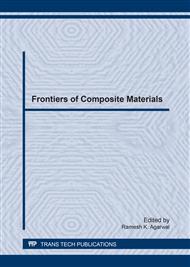p.72
p.76
p.81
p.85
p.89
p.94
p.99
p.104
p.109
Influence of Plasticizers on the Electrical Conductivity of Polyacrylonitrile (PAN)/Lithium-Montmorillonite (Li-MMT) Polymer Composite Electrolyte
Abstract:
With the current trend of miniaturization and portability of electronic gadgets, the development of polymer composite electrolyte (PCE) gained much research interest. In this study PAN matrix was plasticized with various dimethyl formamide (DMF)/ propylene carbonate (PC) ratios. X-ray diffraction (XRD) analysis revealed that both DMF and PC reduce the crystallinity of PAN. Yet, films with higher amount of PC caused much decrease in crystallinity, which is indicated by lowering of full with at half maximum (FWHM) at the utmost 57% when the DMF/PC ratio is 1:2. Differential scanning calorimetry (DSC) analysis also revealed that glass transition temperature (Tg) of PAN decreased from 83.34°C to 50.27°C when plasticized with pure DMF and to temperature lower than ambient condition when PC alone was used. Upon incorporation of 15 wt% Li-MMT, PCEs with pure DMF exhibited the highest electrical conductivity, which is 3.6x10-8 S/cm based on electrochemical impedance spectroscopy (EIS). This suggests that the electrical conductivity is not dictated by the decrease on polymer host crystallinity alone. The type of plasticizer and appropriate combination was shown to have an effect wherein the plasticizer that causes higher degree of solvation and has lower boiling point is thought to provide more hopping sites for electrons due to higher amount of broken bonds in the nitrile group of PAN.
Info:
Periodical:
Pages:
89-93
Citation:
Online since:
March 2017
Authors:
Price:
Сopyright:
© 2017 Trans Tech Publications Ltd. All Rights Reserved
Share:
Citation:


